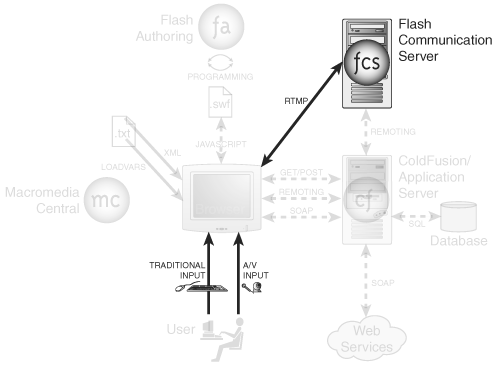Chapter 8. Foundation Communication Server
| [ LiB ] |

In my opinion, the Flash Communication Server (FCS) is the coolest product Macromedia has ever produced. Because it's not always clear what FCS offers over straight Macromedia Flash MX 2004, or when it's an appropriate solution, the primary goal of this chapter is to provide a technical foundation on which you can build while making pure FCS applications. Naturally, you'll be able to add FCS features to other applications, but the examples found here are pure FCS apps. The big step you'll have to take after reading this chapter is to first come up with a cool idea and then work out a solution. (I expect the skills acquired here will make that possible.)
Specifically, this chapter covers the following topics:
-
How to configure and maintain your installed copy of Flash Communication Server
-
How to use remote shared objects to share variables between connected users
-
How to publish and play live or recorded streams (including MP3s)
Flash Communication Server runs parallel to your web server that hosts your SWFs. With a simple "connect" script in your SWF, however, you can set up a persistent connection to the FCS. This is different from the traditional "request and response" behavior of web pages and Flash movies. When users request a web page, they're sent that page (and embedded images and Flash movies), but then they effectively disconnect until they make another request. In the case of the FCS connection, it doesn't disconnect until the user quits or FCS says so. This way a connected movie can be immediately notified of any data as it changes. (An alternative way to keep current is called polling , where a SWF might repeatedly make requests such as "anything new?...anything new?...," which is obviously inefficient.) Macromedia developed a super-efficient means called Real Time Messaging Protocol (RTMP) for the data that travels over a persistent connection between FCS and a user's SWF movie. This is more efficient because data is only transmitted when necessary instead of continually polling to see whether anything's new.
After the connection has been made, you can send all sorts of "messages" to each SWFsimple data such as the value of variables, and live or recorded media such as video and audio. There's really a lot of possibilities, but I suggest we start at the ground and then move up.
Note
The True Cost of Flash Communication Server
My focus is to show you the capabilities of Flash Communication Server (FCS). When you see what's possible, you can determine whether it's worth the price. Note that you can learn and evaluate FCS by downloading the free developer version. For actual deployment, Macromedia offers several other versions supporting various bandwidth and total user limits. In addition, several web hosts have begun to offer FCS support. For example, adding the modest FCS support to my domain hosted at mediatemple.net costs only $15/month. My point is that it's easy to get sticker shock when you see the prices for FCSjust realize you have to balance the value and, also, there's lots of price options.
| [ LiB ] |
EAN: 2147483647
Pages: 120